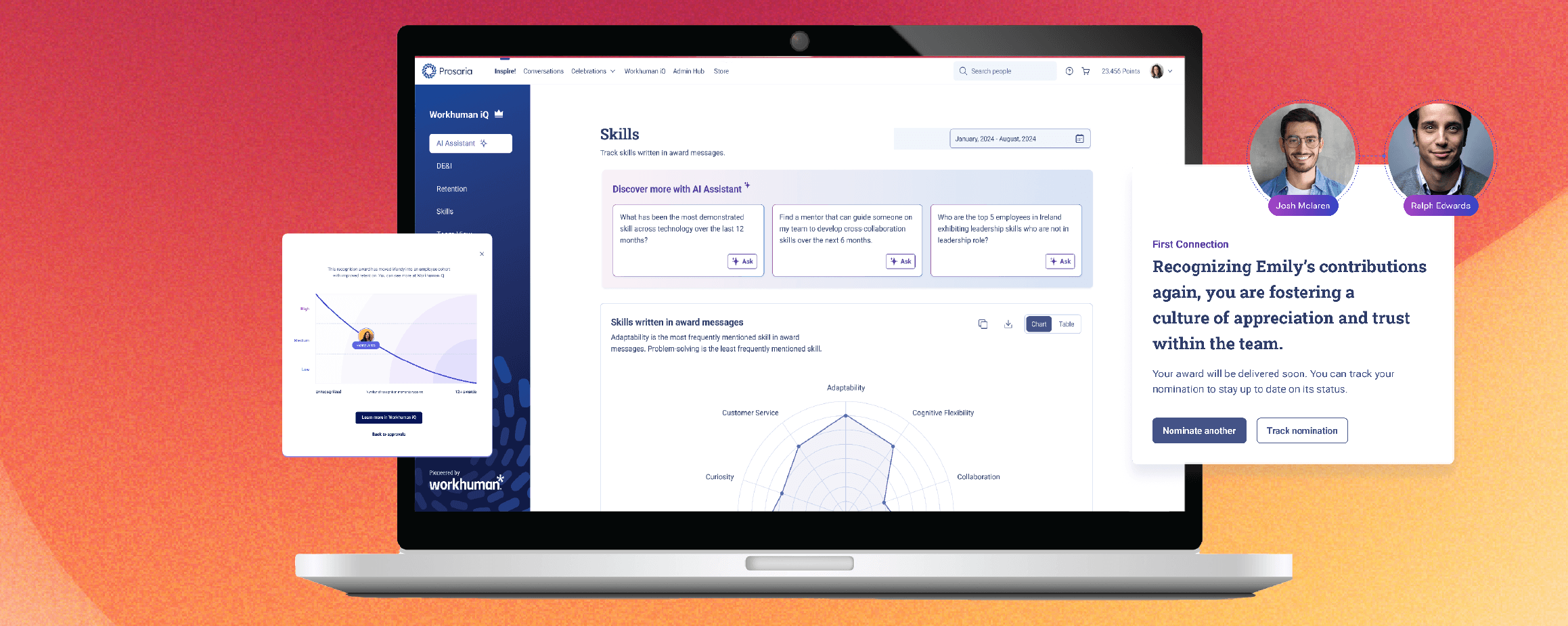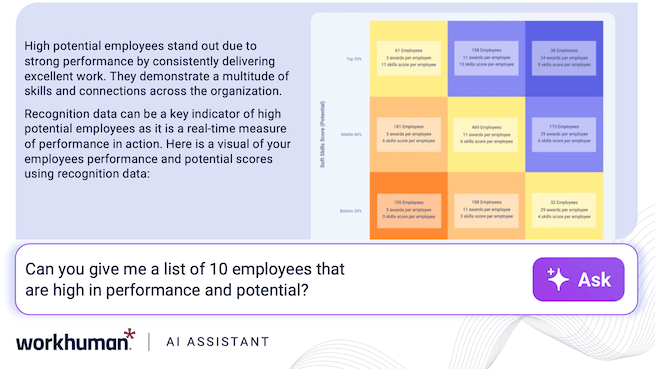How to Measure Company Culture: Metrics, Tools, and Tips to Quantify Your Initiatives
Measuring company culture is notoriously challenging for HR leaders. Culture can feel intangible, and traditional surveys often capture only a snapshot of sentiment, missing the everyday interactions that shape employee experience. Data is frequently scattered across multiple systems, making it difficult to see the full picture or track trends in real time. On top of that, connecting cultural insights to tangible business outcomes like retention, productivity, or innovation can feel like an uphill battle.
Bias and inclusivity also complicate measurement. Many tools rely heavily on self-reported data, which can overlook underrepresented voices or microcultures within teams. Even when insights are available, turning them into actionable initiatives is a struggle. Leaders need a way to translate data into targeted programs that strengthen recognition, engagement, and belonging across the organization.
Read on to learn more about new, actionable strategies and tools that can help you track your team’s ever-evolving culture and guide it in a more positive direction. This step-by-step guide will empower you to take your team’s employee experience from standard to stellar.

1. Understand how measuring culture benefits your business
Before we dive into the details of tracking and analyzing your workplace culture, you should first understand the importance of company culture and how it can massively impact the success of your business:
Helps shape the company’s identity
Having a unique and healthy corporate culture can help in making your organization stand out due to its special identity. This identity can help in aligning the employees around the organization's goals, which can greatly improve productivity rates. In fact, satisfied employees within a healthy company culture showed up to a 12%Opens in a new tab improvement in productivity!
Boosts productivity and performance
By measuring the current state of your company culture using key metrics and modern tools, you can pinpoint the areas of weakness in your company that you can improve. This can clear blockages to productivity and improve performance by recognizing employees for their contributions, as well as identifying and addressing issues that may be holding them back.
This data can also be used preventatively. You can use the data collected from your analyses to “nip things in the bud,” address them head-on, and prevent negative behaviors from finding their way into your organization.

Aids in strategic talent acquisition
A recent report by JobviteOpens in a new tab found that up to 88% of job seekers nowadays would classify company culture as an important factor while looking for a job. The same report also showed that 15% of job seekers turned down job offers due to negative workplace culture, with 33% willing to accept a relatively small pay cut to work at a company with better culture.
When culture is a make-or-break element of work for job seekers, it becomes crucial to ensure that your company is in a positive place to stay competitive.
Bolsters better workforce planning
By maintaining a healthy, positive company culture where employee experience and contributions are appreciated, retention rates may increase dramatically. It's well-known that keeping strong talent is much more cost-effective than hiring replacements, which can save your company a hefty sum of money over time.
Better retention also helps you focus your efforts on growing your business and upskilling or reskilling existing employees, rather than scouting and recruiting untrained replacements.
Fosters equity and inclusivity
A report by DeloitteOpens in a new tab found that 80% of job seekers are mainly interested in applying for jobs at inclusive employers, with 72% ready to leave their workplace for a more inclusive one.
Being an equal opportunity employer with an inclusive work environment not only makes your company more attractive to the best talents, but it also drives more profits with up to 400%Opens in a new tab growth in revenue.
See also: The Ultimate Guide to Organizational Effectiveness: Strategies for a High-Performing Workplace
2. Identify key metrics to track your company culture
Maintaining a positive company culture is a solid long-term investment with a lot of advantages. It’s important that you track the essential company culture metrics to quantify your team’s progress, as well as identify areas for growth.
Classically, these metrics have included:
- Employee turnover/retention rates
- Absenteeism rates
- Employee productivity trends
- Job satisfaction scores (such as eNPS)
- Training and development completion rates
- Rates of employee referrals
- Number of professional development opportunities
- Rates of participation in company events and programs
Many companies are now beginning to add:
- Recognition rates
- Engagement in employee social networks
- Psychological safety
- Fluidity and ease of collaboration (both between and across teams)
- Verbal/written cultural sentiment
By considering new angles for assessing your organizational culture, you may begin to see a clearer picture of what’s working and what isn’t, as well as discover creative, highly-tailored solutions for improvement.
3. Utilize top methods for measuring company culture
Now that you know more about the culture metrics to consider, here are seven tried and true methods that you can use to measure and improve company culture in your organization:
Employee surveys
The most reliable method to gauge your company’s culture is to let your employees share their thoughts and feelings through pulse surveys, especially anonymous ones where they can express their opinions without worrying about negative consequences.
Luckily, there are plenty of surveying tools out there that can help you create, monitor, and keep track of such feedback.

Performance management tools
There are several performance management tools out there that can guide you when it comes to company culture. These tools, such as Workhuman’s Conversations®, track employees’ growth and development in simple, easy-to-follow formats.
Data available in these types of tools may include:
- 360-degree feedback
- Employee key performance indicators (KPIs)
- Personal development plans (PDP)
- Moments of recognition
With a continuous performance management solution, leaders are able to measure growth and performance on a regular cycle (e.g., annually, quarterly), at the end of a project, and when performance improvement plans (PIPs) are needed, all in one place. Managers can choose from a variety of configurable templates and easily access feedback and updates to simplify the evaluation process.
With a continuous performance management platform like Conversations® from Workhuman, managers can keep in touch with their people, making disengagement easy to spot in real time.
People analytics tools
These tools are used by HR teams to collect and analyze a wide range of “people data” about the employees in a company. They have the capability to automate the redundant aspects of HR analytics and help in speeding up the processing of this information into spreadsheets and graphs.
While every analytics tool measures different elements, they mainly focus on employee satisfaction and productivity rates. Workhuman iQ™ takes people analytics a step further by transforming recognition data into cultural intelligence. It identifies patterns in appreciation, collaboration, and inclusion, revealing how culture truly operates across teams.
With real-time dashboards and AI-powered insights, Workhuman iQ helps leaders measure belonging, employee engagement, and performance alignment, turning everyday recognition moments into actionable metrics for a stronger, more connected workplace.

Exit interviews
Employees leaving for new opportunities are great resources to get honest feedback because they're more likely to be honest about the culture in your company than current employees may be. By designing your exit interviews to include analytical questions about company culture, they can help you understand where your culture might be lacking and what steps you need to take to improve culture and retention.
Monitoring behaviors in the work environment
Another method that you can use to measure company culture with decent accuracy is to measure the positive and negative behaviors through a behavioral observation scale.
This helps you identify and keep track of different elements and behaviors that you deem desirable in the workplace. You can encourage these behaviors and eliminate negative ones by implementing a scale system that rewards employees based on these behaviors.
A formal recognition platform, such as Workhuman’s Social Recognition®, can provide invaluable and unexpected behavioral insights. Through observing and tracking who is recognizing whom, and for what contributions, leaders can gain a deeper understanding of present, emerging, or even unrecognized employee skills. This can drive more equitable decisions about growth and development.
Want to see recognition in action to better understand how it drives cultural change? Check out this case study from our partner CAA Club Group for a firsthand account.
Focus groups
Focus groups are a classic strategy yet effective when it comes to assessing company culture. In a company culture focus group, a cross-section of employees is invited to share their reactions and stories about certain behaviors within the workplace. HR leaders can then gather this data and form patterns and trends to provide an assessment of the current company culture and methods to improve it.
Organizational assessment systems
There are different organizational assessment systems that you can use to determine what the culture in your workplace is like.
The first one is the Organizational Culture Assessment InstrumentOpens in a new tab (OCAI), which is a culture tool that can help you distribute 100 points across the 4 major competing values, which are:
- Clan
- Adhocracy
- Hierarchy
- Market
Another type of assessment for company culture is the Business Needs ScorecardOpens in a new tab (BNS), which is a diagnostic tool that measures various aspects of the current and sought-after company culture situation. The culture section of the BNS is split into:
- Engagement and trust
- Communication and instructions
- Providing a supportive environment.
4. Turn cultural insights into actionable change
The cultural insights within recognition data are more than just records of kind words: they’re a map of what drives your culture forward. Every thank-you, shout-out, or peer nomination captures a moment of impact. When those moments are analyzed, they reveal powerful patterns: which teams collaborate best, which behaviors fuel success, and where connection could grow stronger. Turning those insights into action means using what you learn to amplify what works, so recognition becomes not just meaningful, but memorable for the business.
At the heart of this cultural transformation is Human Intelligence™: Workhuman’s unique blend of AI and human data. By analyzing millions of recognition moments, it helps uncover hidden skills, high-performing networks, and emerging leaders. This isn’t about algorithms replacing intuition, it’s about giving people leaders richer context to make smarter, more human decisions. With Human Intelligence, recognition becomes a continuous feedback loop, informing strategy while strengthening engagement.

Insight only matters when it sparks action. The best organizations take what they learn from recognition data and put it to work, celebrating collaboration, identifying growth opportunities, and aligning culture with performance goals. It’s how appreciation evolves from something people feel to something everyone can see: a living, measurable driver of both connection and business impact.
Conclusion
It goes without saying that maintaining a positive company culture is imperative for attracting and retaining top talent. However, measuring and continuously improving your culture may be difficult without the right tools for support. Understanding innovative and emerging ways to track employee satisfaction and other culture indicators can go a long way to support your company’s continuous cultural evolution.
About the author
Anna Picagli
As an RYT500 yoga instructor and a Reiki Master Teacher, Anna is an advocate for holistic wellness, especially within the workplace. She’s extremely passionate about the brain-body connection and exploring how mental and physical wellness intersect.
Anna has experienced firsthand how chronic stress, overworking, poor management, and other organizational issues can lead to extreme burnout. Knowing the impact that a toxic work environment can have on a person’s body, psyche, and general sense of well-being, she now works to direct others away from facing the same fate.
As Workhuman’s Senior Content Specialist, Anna is a regular contributor to Workhuman iQ reports and aims to create resources that company leaders can reference to help improve their culture and empower their employees, creating healthier workplaces for everyone.
In her free time, she’s an avid solo traveler, a voracious reader, and a seasoned home chef. You can learn more about Anna’s work on LinkedIn or through the Yoga Alliance.